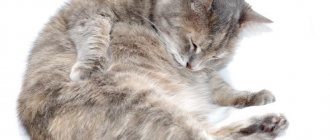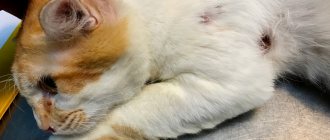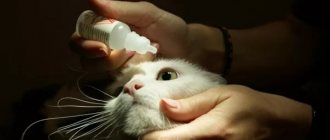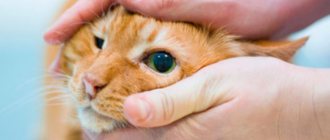In cats, spotting can be either normal or a sign of serious illness. In the first case, they accompany normal physiological processes, such as estrus or cleansing of the uterine cavity after childbirth. But if the discharge appears at the wrong time, causes discomfort to your pet and has a foul odor, you should consult a veterinarian as soon as possible. If this is not done, the animal may die.
So, how to distinguish normal discharge from pathological ones and how to treat a cat?
Reasons for appearance
Normally, bloody discharge appears in a cat for the following reasons:
- Estrus. The discharge indicates that the cat is ready to mate and bear offspring; its duration is several days. At the same time, the secretion does not have an unpleasant odor, and when the animal licks itself, it does not leave marks on surrounding objects. It is important to remember that spotting during estrus is typical for untied cats. After the first birth they will always be transparent.
- During pregnancy. Normally, during the entire period when a cat is bearing offspring, she should not be bothered by discharge. Ichor may be released during contractions.
- After the birth of kittens. The animal’s body is recovering, so during the first three weeks after birth, the presence of spotting is considered normal. In this case, the pet should feel well, eat as usual and carefully care for the offspring. If the discharge continues for more than the specified period, and the cat becomes lethargic, then it needs to be shown to a veterinarian.
A small amount of blood from the uterus can be released in cats only for the reasons described above. If the secretion is copious, foul-smelling, or includes particles, then this may be a symptom of many diseases of the genitourinary system or a sign of uterine bleeding.
Endometritis
Inflammation of the uterine mucosa. The cause is genital infections. Animals walking on the street, young cats under 3 years of age, when using hormonal drugs for estrus, an unbalanced diet, difficult childbirth, and a hereditary tendency are at risk.
The disease is considered in acute or acquired form. Let's look at the symptoms. In the acquired form, symptoms are mild. The pet looks healthy in appearance, but often licks itself, so the cat’s blood from the uterus is not visible. The danger is that this form can become purulent. This is due to increased accumulation of secretions due to thickening of the uterine mucosa. The secretion is a favorable environment for the development of infections. Characterized by copious discharge and increased body temperature. Urgent medical assistance is required.
Symptoms in acute form
:
- temperature increase;
- loss of appetite;
- copious discharge from the genital opening;
- often arches his back and assumes a posture for urination;
- abdominal enlargement;
- the external genitalia are inflamed.
At an early stage, antibiotics and antimicrobials are used. In case of purulent form, sterilization is carried out. To increase the body's defenses, immunomodulators are prescribed.
Dangerous diseases
Cats may experience atypical bloody discharge, which is a symptom of the following diseases:
- endometritis and pyometra are infectious diseases in which the uterine mucosa becomes inflamed and begins to bleed;
- inflammatory processes in the genital organs - their causes are varied, ranging from stress to infection, often ending in cystitis;
- phlegmon - under the influence of unfavorable factors, the cat experiences swelling of the genitals and the formation of ulcers;
- vaginitis - inflammation of the vagina caused by infections or injuries after unsuccessful medical procedures;
- tumor process in the uterus - as a rule, it is malignant in nature, the animal experiences destruction of soft tissues;
- placenta in the uterus - if not all placenta came out during childbirth, this leads to an inflammatory process in the uterus;
- various injuries to the genital organs - most often the cause is a poorly performed operation, which leads to bleeding.
The diseases described above have many similar symptoms:
- the animal becomes lethargic and drowsy;
- the cat tries to hide from its owners and other pets and shows no interest in playing;
- food refusal is observed, the animal may not drink well;
- a secretion is released from the genital organs, which, depending on the pathology, can be foul-smelling, with traces of pus and particles of mucous membrane;
- blood loss continues for a long time without a tendency to stop;
- The animal's temperature rises and does not subside.
To find out what exactly your pet is sick with, you need to contact a veterinarian as soon as possible. Independent attempts to find out what exactly is happening with the cat will not only not lead to success, but will also lead to the loss of precious time.
Risks of the condition
Regular or large amounts of blood loss can weaken even the strongest organism, which cannot cope with bleeding on its own without outside intervention. Severe blood loss in a cat can result in the following:
A single bleed in a cat is not dangerous.
- disruption of mechanical circulatory function;
- insufficient filling of blood vessels and cardiac compartments with blood;
- falling blood pressure;
- a sharp decrease in red blood cells and a drop in hemoglobin levels leads to the development of anemia;
- tissue hypoxia (oxygen starvation) due to a disrupted process of oxygen transfer through vessels to tissues and organs;
- disruption of local metabolic processes, which leads to massive cell death, and then the death of the organism.
Treatment
Before starting to treat the animal, the doctor finds out the root cause of the discharge. This will require the following examinations:
- initial examination of the animal, careful palpation of the abdominal area;
- general and biochemical blood test, laboratory urine test;
- Ultrasound of internal organs;
- examination of the uterus using a colposcope;
- study of secretions;
- bacterial culture to identify the pathogen;
- biopsy of the mucous membranes of the genital organs.
Based on the research results, the doctor makes a diagnosis and prescribes the necessary medications and procedures.
Depending on the reason for the bleeding, the cat is prescribed the following treatment:
- Anti-shock therapy is carried out using painkillers.
- If your cat is bleeding heavily, a blood transfusion may be required.
- If the bleeding is caused by low blood clotting, then corrective therapy is prescribed.
- For pathologies such as tumors or endometritis, surgery followed by chemotherapy is indicated to reduce the risk of relapse.
- The animal is prescribed antibiotics when the disease is caused by pathogenic microorganisms.
All medications and their dosage can be prescribed and adjusted only by a veterinarian. Self-medication will not only not bring a positive result, but can also lead to the premature death of your pet.
Bloody discharge in cats
Blood discharge in a cat is almost always not a good sign, indicating serious illness. It is not possible for the owner to figure out on his own what the reason for this is.
An examination in a hospital setting, tests, ultrasound, and possibly cytological and histological studies will be required.
Our network of clinics has all the necessary equipment, so the examination will take place quickly, and soon the results of the research will be in your hands. Based on them, the veterinarian will draw a conclusion about what is wrong with your pet and begin immediate treatment for the cat.
Bloody discharge in a cat can indicate a serious pathology, sometimes when it occurs it can take hours, so don’t delay, contact your veterinarian for help as soon as possible. Only an experienced doctor who has the necessary equipment to conduct an examination will be able to accurately determine the cause and help save your cat’s life!
Prices for appointments in our clinics
| Name of veterinary services | Unit | Price, rub |
| ⭐ Initial appointment | 1 animal | 400 |
| ⭐ Repeated appointment | 1 animal | 250 |
| Initial appointment with a specialist | 1 animal | 1100 |
| Consultation without an animal | — | 550 |
| Consultation with a doctor based on test results | 1 PC. | 400 |
| Weighing animals | 1 animal | For free |
| Additional fixation for aggressive animal behavior | 1 animal | 700 |
APPOINTMENT AT THE CLINIC
HOME CALL
All our Veterinary Clinics:
For any suggestions regarding the site: [email protected]
|











